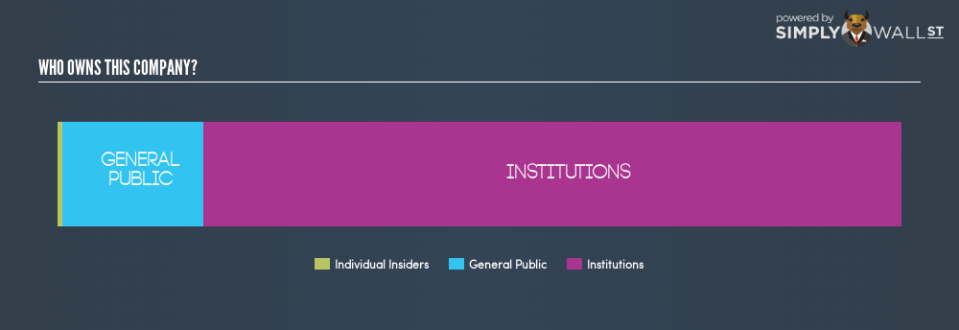Who Owns Most Of The Progressive Corporation (NYSE:PGR)?

In this article, I will take a quick look at The Progressive Corporation’s (NYSE:PGR) recent ownership structure – an unconventional investing subject, but an important one. When it comes to ownership structure of a company, the impact has been observed in both the long-and short-term performance of shares. Since the same amount of capital coming from an activist institution and a passive mutual fund has different implications on corporate governance, it is a useful exercise to deconstruct PGR’s shareholder registry.
Check out our latest analysis for Progressive
Institutional Ownership
In PGR’s case, institutional ownership stands at 82.66%, significant enough to cause considerable price moves in the case of large institutional transactions, especially when there is a low level of public shares available on the market to trade. Although PGR has a high institutional ownership, such stock moves, in the short-term, are more commonly linked to a particular type of active institutional investors – hedge funds. For PGR shareholders, the potential of this type of share price volatility shouldn’t be as concerning as hedge fund ownership is is not significant,indicating few chances of such sudden price moves. While that hardly seems concerning, I will explore further into PGR’s ownership type to find out how it can affect the company’s investment profile.
Insider Ownership
An important group of shareholders are company insiders. Insider ownership has to do more with how the company is managed and less to do with the direct impact of the magnitude of shares trading on the market. PGR insiders may only hold a a minor stake in the company, but this is a relatively significant holding given it is a large-cap stock. A higher level of insider ownership has been linked to management executing on high-returning projects instead of expansion projects for the sake of apparent growth. In addition to this, it may be interesting to look at insider buying and selling activities. Keep in mind that buying may be sign of upbeat future expectations, but selling doesn’t necessarily mean the opposite as the insiders might just be doing it out of their personal financial needs.
General Public Ownership
The general public holds a substantial 16.62% stake in PGR, making it a highly popular stock among retail investors. This level of ownership gives retail investors the power to sway key policy decisions such as board composition, executive compensation, and potential acquisitions. This is a positive sign for an investor who wants to be involved in key decision-making of the company.
Next Steps:
PGR’s considerably high level of institutional ownership calls for further analysis into its margin of safety. This is to avoid getting trapped in a sustained sell-off that is often observed in stocks with this level of institutional participation. However, ownership structure should not be the only focus of your research when constructing an investment thesis around PGR. Instead, you should be evaluating company-specific factors such as the intrinsic valuation, which is a key driver of Progressive’s share price. I highly recommend you to complete your research by taking a look at the following:
Future Outlook: What are well-informed industry analysts predicting for PGR’s future growth? Take a look at our free research report of analyst consensus for PGR’s outlook.
Past Track Record: Has PGR been consistently performing well irrespective of the ups and downs in the market? Go into more detail in the past performance analysis and take a look at the free visual representations of PGR’s historicals for more clarity.
Other High-Performing Stocks: Are there other stocks that provide better prospects with proven track records? Explore our free list of these great stocks here.
NB: Figures in this article are calculated using data from the last twelve months, which refer to the 12-month period ending on the last date of the month the financial statement is dated. This may not be consistent with full year annual report figures.
To help readers see past the short term volatility of the financial market, we aim to bring you a long-term focused research analysis purely driven by fundamental data. Note that our analysis does not factor in the latest price-sensitive company announcements.
The author is an independent contributor and at the time of publication had no position in the stocks mentioned. For errors that warrant correction please contact the editor at editorial-team@simplywallst.com.

